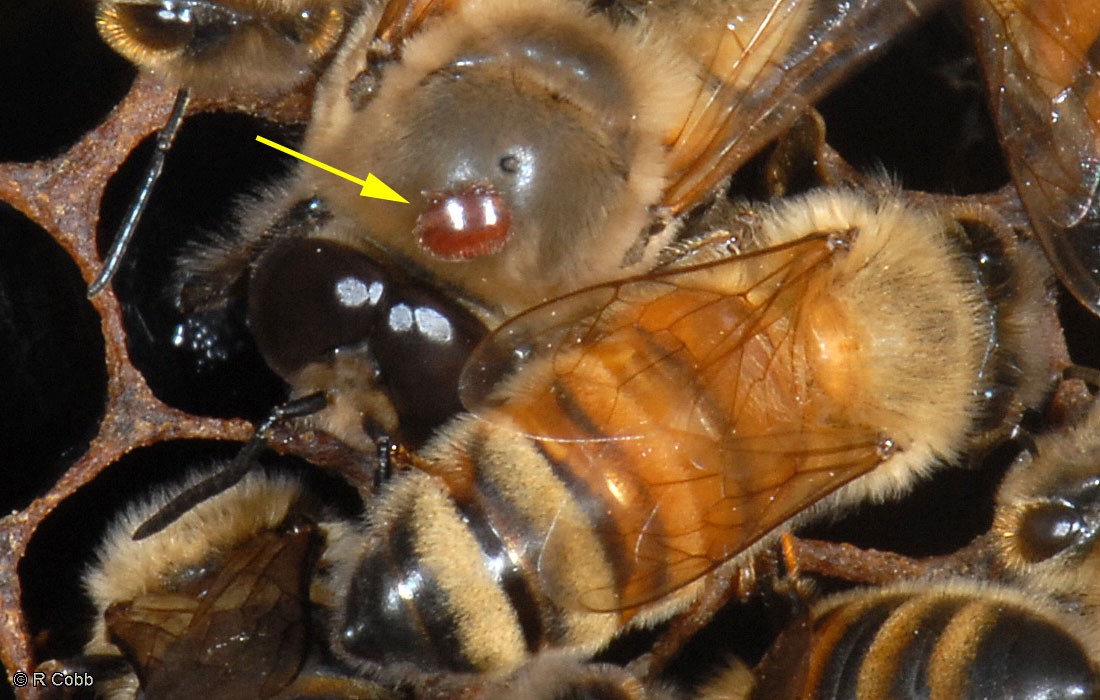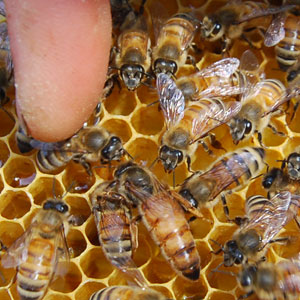Alright, now that we've begun to lay down a foundation for our beekeeping knowledge, it is my duty to inform you that you will be learning a new language. As with any new skill, learning the lingo is necessary. I've put together a dictionary of some of the basic words a beginning beekeeper may need to know. A whole new world has just been opened, and the accompanying terminology must be mastered. So lets take a look at some of the everyday beekeeping vocabulary. We'll discuss some of the more basic words and terminology that beekeepers use quite often. I'll throw in some advice or personal experiences in here if I think it will be beneficial.
Apiary -- A bee yard, or place where operational hives are kept. A well maintained apiary will generally have no more than 25-40 hives, depending on the resources in the immediate area. Honey
and pollen production will lower, diseases spread much easier, and bees
from one hive may try to take from another hive's honey supply if too many hives compete for limited resources.
Apiarist -- A beekeeper.
Bait Hive -- An empty hive body set out to attract swarms of bees. Also called a swarm trap or decoy hive. Lures can be bought to be put in the hive as another means of attracting a swarm. (Personally, I've never had any luck with the attractants.)
Bee Bread -- Main source of protein for a hive. Bees will pack pollen into cells, and mix in nectar, enzymes, bacteria and fungi. Fed mainly to the Queen and Brood.
Bee Brush -- A soft-bristled brush used for removing bees from a frame or comb.
Bee Space -- A space 5-8 mm which allows passage for the bees within the hive. It is too small to build comb in the area, but large enough to prevent propolis buildup.
Bee Vac -- Generally converted from a shop vac, a bee vacuum is used to gather bees during removal, or cutout. When extracting a swarm from an enclosed area, especially when the swarm is in a building, this is one of the best methods to remove as many bees as possible. However, the vacuum needs to be used with caution. If the suction power is too high, it may kill the bees.
Beeswax -- A substance produced by a bees abdominal gland. Bees will chew it to soften it, and then shape it into honeycomb cells to store honey and pollen, or as a place for brood.
Brood -- Immature bees that have not left their cell. That is to say, an egg, larvae, or pupae.
Burr Comb -- Small pieces of comb outside the normal space on a frame where honeycomb usually is. Bees might even build honeycomb on the lid of the hive.
Cappings -- A thin sheet of wax covering the honey in a hive. Cappings are cut off in order to extract honey from the frames.
Cell -- A hexagonal structure that makes up honeycomb in which eggs are laid, and honey and pollen are stored.
Colony -- The amassed combination of brood, worker bees, drones, and Queen living together as a unit in a hive or other dwelling.
Colony Collapse Disorder (CCD) -- A recently coined phrase referring to the abrupt disappearance of a large group of bees from a hive. CCD has happened here and there throughout history, but took an abrupt and dramatic rise in the later part of 2006. It has become a severe problem for commercial, with sometimes up to 50% of established beehives dying off in a single season.
Disease Resistance -- The ability of a hive to avoid a particular disease, generally through genetic immunity or avoidance behaviors.
Drone Brood -- Cells that are larger than worker cells, in which drone brood is laid and pollen is stored.
Domestic -- Bees that live in a man-made hive.
Drone -- A male honeybee that comes from an unfertilized egg that is laid by the queen, or an occasional laying worker. Drone's sole purpose for existence is to mate with the queen bee. After mating with the queen, a drone will die. Those that do not mate will be shoved out of the hive and left to die in the fall, as all they do is sit around and eat.
 |
| Worker and a Drone |
Entrance Reducer -- A strip of wood in the entrance used to reduce the size of the hive entrance.
Field Bees -- Worker bees that are generally 21 or more days old and work out of the hive to collect nectar, pollen and water. Field bees are often called foragers.
Foundation -- Thin sheets of plastic (generally covered in beeswax) that are stamped with worker cell shape on which worker bees will build the comb to store honey.
Frame -- A rectangular-shaped wooden structure designed to hold honeycomb. They are also built to keep other frames a "bee-space" apart while in the supers.
Glucose -- A simple sugar, glucose (also known as dextrose) is one of the two main sugars in honey, and forms most of solid phase in granulated honey.
Guard Bees -- Worker bees about three weeks old that challenge other bees entering the hive and other intruders. At three weeks old, bees have the maximum amount of alarm pheromone as well as venom in their stingers.
Hive -- Physical dwelling for a colony of bees.
Hive Body -- A wooden box containing frames. (Usually refers to the size of box used for brood.)
Hive Tool -- Perhaps the most useful tool for a beekeeper, a hive tool is a flat metal device curved at one end and flattened at the other. Used for prying and scraping.
Honey -- Liquid Gold! Need I say more?! A viscous liquid produced from the nectar from flowers by bees as a source of nourishment. Honey is composed of mainly of Fructose and Glucose dissolved in roughly 17% water. Also contained are small amounts of vitamins, minerals, sucrose, enzymes and proteins.
Honey Flow -- A time where enough nectar-producing flowers are blooming that bees can produce a surplus of honey.
Honey Extractor -- A machine designed to remove honey from the honeycomb on frames by spinning it out with centrifugal force.
Hornets and Yellow Jackets -- Social insects that nest in paper or foliage material, with an overwintering queen. Often mistaken for bees, hornets, yellow Jackets, and wasps are easily distinguishable from bees by their hairless, shiny bodies and an aggressiveness that honey bees lack. It is the opinion of the author that hornets, yellow jackets and wasps are good for nothing except annoying the living daylights out of beekeepers.
 |
| Yellow Jacket |
 |
| Wasp |
| Hornet |
Infertile -- Incapable of producing a fertilized egg. Can be lain by a laying worker, or a drone laying queen. Unfertilized eggs develop into drones.
Larvae, open -- The second developmental stage of a bee, starting the 4th day from when the egg was laid. Larvae are capped on the 9th or 10th day.
Larvae, capped -- The third developmental stage of a bee, ready to pupate at about 10 days from an egg.
Migratory Beekeeping -- A method of beekeeping where colonies are moved from one location to another in order to take advantage of two or more honey flows or for pollination.
Movable Frames -- A frame designed to preserve the bee space necessary for a functional hive, as well as easily removed.
Natural Comb -- Comb that has been naturally built without foundation.
Nurse Bees -- Bees that feed and take care of the developing brood, generally 3 to 10 days old.
Observation Hive -- A hive designed from glass, plastic, or other clear material that allows observation of the bees at work.
Packaged Bees -- A quantity of bees, (generally measured by weight in pounds) contained in a screened container and shipped around the world to beekeepers.
Parasitic Mites -- There are two types of mites that are physically dangerous to bees, and economically dangerous to beekeepers. Varroa and Tracheal. There are other known mites that do not cause any known problems to bees.
 |
| Tracheal Mites |
 |
| Varroa Mite |
Pollen -- The dust-like reproductive cells of flowers that act as important proteins for bees, and is essential for raising brood.
Propolis -- Plant resins that are collected by bees, who add enzymes from their saliva, and use it to fill in small places and cement things in place, as well as a sterilant. Propolis has antimicrobial properties.
Pupa - The third developmental stage of a bee. During this stage, a bee is inactive and in a cocoon.
Queen -- The fully developed female that is responsible for the egg laying in the colony. All activities in the hive are centered around the queen.
 |
| Honey Bee Stinger |
Sucrose -- The principle sugar found in nectar.
Sugar Syrup -- A ratio of sugar and warm water used to feed the bees.
Sugar Syrup -- A ratio of sugar and warm water used to feed the bees.
Supers -- Boxes with frames in which bees store honey. It is almost always placed above the boxes with brood in them.
Swarm -- A collection of bees with at least one queen that has split apart from the mother colony with the intent of starting a new colony. This is the natural method of propagation for honeybee colonies.
Swarming Season -- The time of year, usually late spring/early summer when swarms generally are trying to find a new location.
Top Bar Hive -- A hive that uses just the top bar of a frame that still allows for movable comb. The intent is either to save on expenses, or to produce more comb honey.
Uncapping Knife -- A knife heated by hot water, steam, or electricity that is used to shave off the cappings during extraction. (To be honest, the author has never had really good luck using this either.)
Uncapping Tank -- A tank over which the frames of honey are uncapped. The tank usually strains the honey before it is collected.
Worker Bees -- Infertile female bees that are responsible with carrying out all of the different duties of the colony.




Thank you for sharing. Interesting blog. I am using stainless honey extractor for safe extraction.
ReplyDeleteValuable information in your blog and I really appreciate your work and keep it up dude I really very informative blog about the Michigan Bee Wasps keep posting.
ReplyDeleteMichigan Bee Wasps Hornet Nest Removal Specialists
It takes gigantic learning to deliver this bit of craftsmanship.
ReplyDeletetop-5-best-honey-extractors
An entire new biosphere has just been unlocked, and the supplementary language must be grasped. So let’s take a look at some of the ordinary beekeeping suits.
ReplyDelete